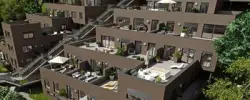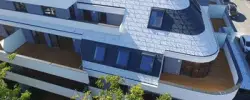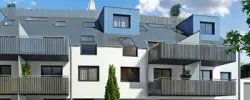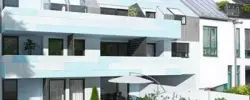Hillresorts am Schlosspark
Return
6% p.a.
Duration
12 months
Project type
Growth
Distribution
Yearly
Notice according to § 12 (2) Vermögensanlagengesetz
This investment involves considerable risk and may result in partial or total loss.Project Presentation
An eight-storey beautiful terrace house complex including underground parking and 1,374 m² of open space forms the architectural core of this modern new building project in the quiet Baiernstraße 52 in Graz. From the ground floor to the sixth floor, a total of 32 comfortable and light-flooded condominiums with sizes ranging from 45 m² to 115 m² are available for selection. As the majority of these condominiums are equipped with generous open spaces (terrace or balcony), nothing stands in the way of stylish living with a baroque neighbourhood.
Baroque buildings and a variety of wonderful green oases are available in the Styrian capital Graz. But who can claim to live next to a UNESCO World Heritage Site, which was once made an architectural reflection of the universe by Prince Hans Ulrich von Eggenberg? At the foot of the Plabutsch mountain in the Eggenberg district of Graz to the west, Styria's largest baroque castle will soon be happy to have new neighbours: not far from the extensive historical castle park, AIRA Real Estate Development GmbH is realising a particularly exclusive real estate project for smart investors and discerning buyers on a green hillside.
The project has already been granted planning permission and construction work will begin in summer 2019. Even before the start of construction, 7 apartments have already been sold, which corresponds to a preliminary valuation of 20%.
Location
In the southern part of Austria, marked by a Mediterranean climate, numerous green oases and above-average hours of sunshine, lies the Styrian capital Graz. Graz not only captivates with its Mediterranean joie de vivre, but above all with its mix of baroque buildings and future-oriented modern architecture and attracts a large international audience. The diverse cultural and educational opportunities as well as the proximity to the South Styrian wine country make Graz a city that is particularly worth living in. In 1999 the Inner City of Graz was declared a UNESCO World Heritage Site because of its buildings worthy of protection. The Inner City contains a historic old town centre with the Schlossberg and the city park, bordered by the river Mur. In the inner city you will find numerous shopping centres, street markets, galleries, museums, pubs and restaurants. In terms of transport, all important sights can be reached within a very short time by the excellent Graz tram network as well as by bicycle and on foot. As a university city with over 60,000 students, Graz is considered the fastest growing Austrian conurbation of the last ten years.
Historically, the Grazer Feld was a densely populated agricultural landscape during the Roman Empire. The name "Graz" is derived from the term "castle", which was built there in the 6th century. From the 13th - 16th century, Graz was a Habsburg royal seat. In 2003 Graz became the cultural capital of Europe, which is still distinguished by its rich cultural offerings.
Discover the surroundings
Strolling in the fantastic park landscapes of Schloss Eggenberg, relaxing in the new sports and wellness pool "Auster" or shopping in the trendy Annenstraße around the Graz Kunsthaus: The district of Eggenberg, which covers almost 8 square kilometres in the west of Graz, offers its almost 20,000 inhabitants an above-average quality of life in many respects. Schools, kindergarten, FH Joanneum, city library, UKH Graz and LKH Graz-West as well as the Eggenberger Allee with various grocery stores, restaurants, banks, post office and pharmacy can be reached in a few minutes as well as the motorway junctions to the A2 Südautobahn and A9 Pyhrnautobahn. The connection to public transport is provided by tram lines 1 (Eggenberg-UKH) and 7 (Wetzelsdorf), which take you via the main railway station directly to the city centre, which is about 15 minutes away. The municipal bus lines 33, 33E, 62, 64 and 85 of Holding Graz also run not far from the location and leave every 10 minutes to the city centre. Nature lovers and recreational athletes have also been well catered for: At Graz's popular local mountain Plabutsch, extensive cycling and hiking trails and a wonderful view of the city await you.
Eggenberg Castle / Castle Park
Schloss Eggenberg in Graz is the largest and most important baroque castle complex in Styria. With its preserved original furnishings, the extensive landscape garden and the collections of the Universalmuseum Joanneum housed in the castle, it is one of the most valuable cultural assets in Austria. As the ancestral seat of the Eggenberg noble family, the history of its construction and furnishings shows the changes and patronage of what was once the most powerful family in Styria. In 2010, the castle was added to the existing UNESCO World Heritage City of Graz-Historical Centre in an extension.
OYTER / Wellness Oasis
The 2,000 m² sauna landscape of the Graz Oyster Wellness Spa, which extends over 2 floors, promises relaxation and recreation. Relaxation pool, saltwater pool, whirlpools, salt bath, steam bath, generous resting areas as well as guided special infusions are included in the wellness bath. The highlight is the 'Pearl' outdoor sauna, where wellness guests benefit from sufficient space and can switch off completely when listening to music. Refreshment afterwards is provided either by a cold shower or a drink or a small snack at the sauna bar.
FH Joanneum
FH Joanneum (own spelling: FH JOANNEUM) is a university of applied sciences in Austria with 4700 students, around 300 full-time lecturers and academic staff and around 960 lecturers. It offers degree programmes with a focus on economics, technology, health sciences and social sciences at its three locations in Graz, Kapfenberg and Bad Gleichenberg in Styria and is one of three Universities of Applied Sciences in Austria that do not charge tuition fees.
UKH Graz
The Unfallkrankenhaus Graz is located in the district of Eggenberg, in the northwest of the Styrian capital Graz and is operated by AUVA. It has 145 beds and treats an average of 50,000 patients per year, of which about 7,200 are admitted as inpatients. The treatment spectrum on the 6 wards
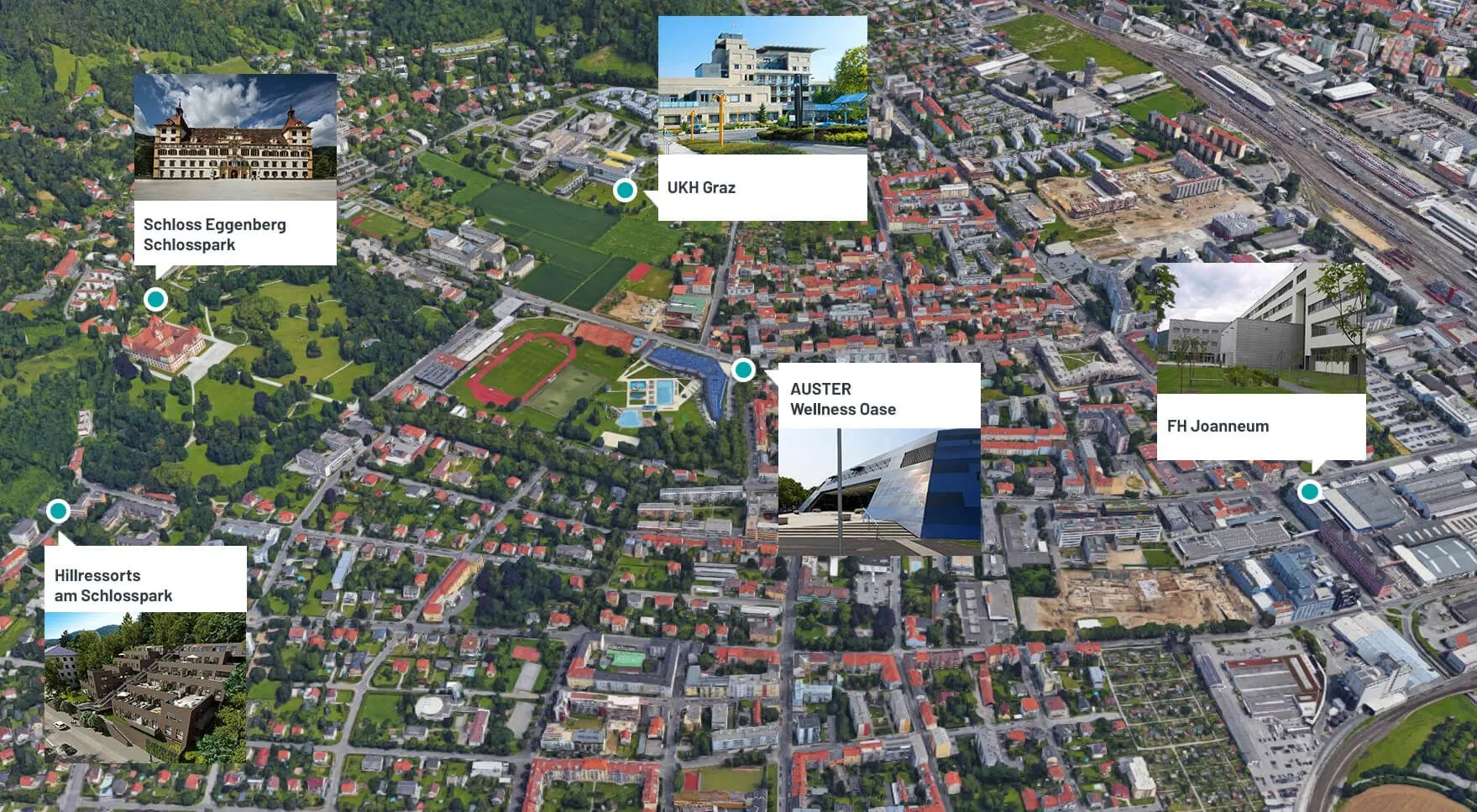
Team
The AIRA Development Group is a company founded in 2013 by Arthur Iliyav and Roman Ascherov, which has positioned itself very successfully as a property developer and project developer in Austria. Under the management of Ewald Streicher, the managed project volume is currently around EUR 35.4 million.
The AIRA Development Group specialises above all in the development of high-quality and high-value new construction projects. The purchase and sale of selected apartment buildings complements AIRA's business model.
The AIRA Development Group considers its customers to be its most important capital. Optimal service is at the centre of the company philosophy. Customer wishes are perceived and implemented by AIRA. In general, the wishes of AIRA's customers regarding the housing project are analysed at the time of purchase. In this way AIRA optimizes floor plans, compares prices in the surrounding area and optimally implements the requirements in all areas. Not the maximum profit, but the extremely satisfied customer is important. AIRA is able to achieve good returns due to the rapid project lead times of 12 to a maximum of 24 months and a quick marketing.
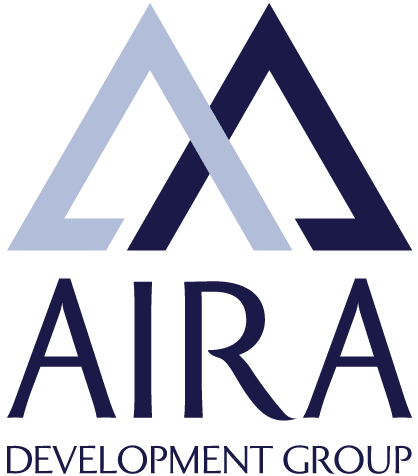
AIRA Development Group GmbH


